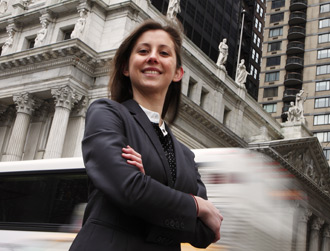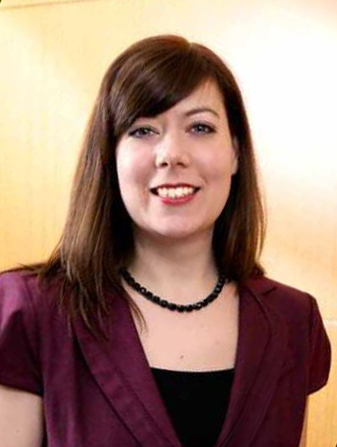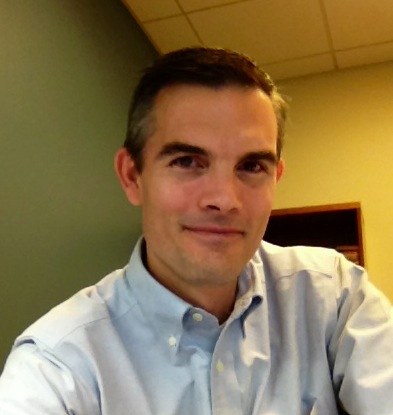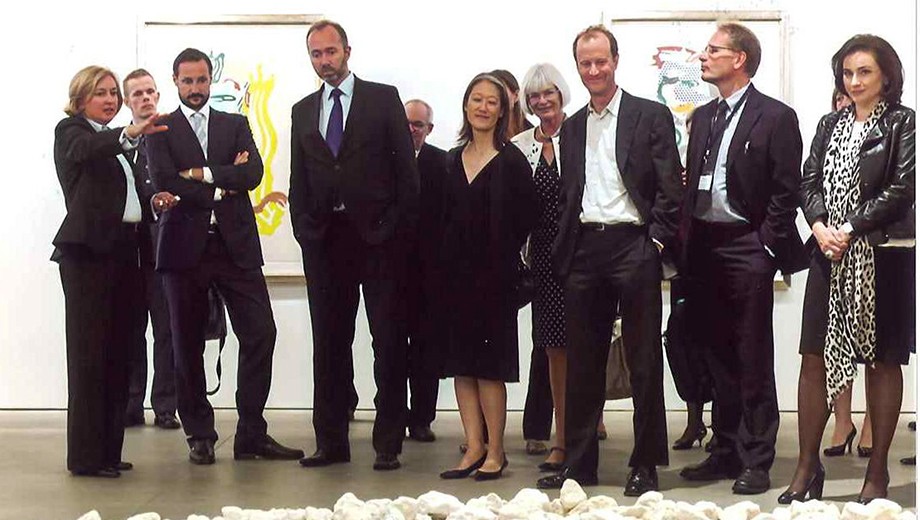Senior Program Associate
Director of Community Involvement
Executive Director
Officer, Planning and Evaluation
How did you find your way to your current job?
 Pauline Eveillard: After graduating from the Master of Arts Program in the Humanities (MAPH), I met with staff at the World Monuments Fund for an informational interview. They called me back to ask if I would be interested in an entry-level administrative job in the program department, because someone had recently left—and so I applied, got the job, and now I’ve been here four years. What’s great about World Monuments Fund is that everyone kind of comes here by their own path—architecture, art history, engineering, historic preservation—and so there’s an interdisciplinary and collaborative approach to it, which I like.
Pauline Eveillard: After graduating from the Master of Arts Program in the Humanities (MAPH), I met with staff at the World Monuments Fund for an informational interview. They called me back to ask if I would be interested in an entry-level administrative job in the program department, because someone had recently left—and so I applied, got the job, and now I’ve been here four years. What’s great about World Monuments Fund is that everyone kind of comes here by their own path—architecture, art history, engineering, historic preservation—and so there’s an interdisciplinary and collaborative approach to it, which I like.
 Beth Gallagher: When I completed MAPH I was pretty clear that I wanted to move into a nonprofit role, so I spent some time on the job trail—about five months—and got to know a number of institutions in Chicago. I think I interviewed at WTTW and the Field Museum and the Newberry Library, looking at development roles, but I ended up in a fantastic role at a social service agency—in an administrative position, which I wanted for the specific purpose of getting a kind of bird’s-eye view into how nonprofits run. I worked with the executive director and board of directors there and then ultimately did some fundraising as well. And through my fundraising work, I found that there’s this wonderful niche role within the corporate community in corporate giving.
Beth Gallagher: When I completed MAPH I was pretty clear that I wanted to move into a nonprofit role, so I spent some time on the job trail—about five months—and got to know a number of institutions in Chicago. I think I interviewed at WTTW and the Field Museum and the Newberry Library, looking at development roles, but I ended up in a fantastic role at a social service agency—in an administrative position, which I wanted for the specific purpose of getting a kind of bird’s-eye view into how nonprofits run. I worked with the executive director and board of directors there and then ultimately did some fundraising as well. And through my fundraising work, I found that there’s this wonderful niche role within the corporate community in corporate giving.
Laura Satersmoen: I worked at various museums over the years, big and small—including the University of Chicago’s Smart Museum, which is an institution I’m very fond of because they gave me my start along with a lot of training. I also worked at the Art Institute of Chicago as well as for a commercial art dealer in Chicago. Then I moved to San Francisco and worked for a couple of artists, and at an art college in the Bay Area as a curatorial assistant.
I got the job that I currently have about 17 years ago. When I first started out I was working on a part-time, temporary project. But very soon after, the Fishers asked if I wanted to work for them full-time. So I did, and the rest is history—my job has grown a lot and now I manage everything that has to do with this family’s private art collection.
 Christopher Strawbridge: While I was at UChicago, to pay the bills I started working with a consulting firm and ultimately took a permanent position with them after I graduated. Then life intervened, my wife and I moved back to Philadelphia, and I looked around for employment. I’d been working in the nonprofit world before grad school, and the way I look at it is: there are places that need to find money to do what they do, and there are places that give it away. I wasn’t really interested in asking for money, so I wanted to look on the giving side.
Christopher Strawbridge: While I was at UChicago, to pay the bills I started working with a consulting firm and ultimately took a permanent position with them after I graduated. Then life intervened, my wife and I moved back to Philadelphia, and I looked around for employment. I’d been working in the nonprofit world before grad school, and the way I look at it is: there are places that need to find money to do what they do, and there are places that give it away. I wasn’t really interested in asking for money, so I wanted to look on the giving side.
What is the relationship between your academic background and your professional career?
PE: While the subject matter I studied has been beneficial to my profession at World Monuments Fund, MAPH’s emphasis on critical thinking has been even more important.
BG: Smart people are never undervalued—the critical thinking and the communications skills you get in MAPH are always valuable, regardless of your work environment. If anything, I think my degree just demonstrates the caliber of work that I’m able to do—so you don’t need an MBA to be contributing in corporate America. Everybody can serve.
LS: I studied modern art; I did my master’s thesis on Robie House at University of Chicago, Frank Lloyd Wright. The collection I work with now is a little later—more contemporary art, but still close. What I’ve done since I’ve been in an academic environment has just built on that foundation. I’m consistently amazed when I see people working in the field who don’t have some basic understanding of history, for example. I think you need the background in art history, or history, or whatever your foundation works on, in order to do the job well.
CS: An organization as large as Templeton needs to have an office that does planning and evaluation. We want to look at what we're doing and ask, “What does it all mean? Are we getting any place?” We need to carry out our mission, and we need academics to want to work with us and to do the kind of research that helps us get there. To that end, I think it’s helpful if you come from an academic background and can speak to that culture.
What advice would you give other graduates seeking a similar path?
PE: It’s important to stay open-minded, to think creatively about job opportunities, and to take chances. With an art history background, your opportunities may seem narrow: working at an auction house or gallery or museum, and I think a lot of people see it as limited to that list. But there are other places to work like your local preservation office, arts nonprofits, or the landmark commission office.
BG: I think any experience on the nonprofit side is really valuable if you’re going into grant-making; it’s critical to understand some of the challenges that nonprofits face and really appreciate how they operate, so that it’s not just a transaction. The one thing I would encourage is just, talk to people, use Career Advancement, and do as many informational interviews as you can to better understand what different work environments are like, what are the benefits and challenges at different types of places, and to build your network. Plus, just practicing talking to people gets you prepared for job interviews.
LS: Having any kind of business experience—whether it’s accounting or legal or efficiency or deadlines or expectations or the bottom line—is really helpful. Additionally, people should be flexible when they’re looking for a job in the arts or in a foundation. I started my job on a part-time, temporary basis; I had no idea it would lead to where it led. I don’t think people can have a really rigid idea about what their careers are generally because so many people change careers, change jobs, change ideas about things, and the world is changing too so you have to keep up with it.
CS: An academic career often supports the notion that the aim of research is to publish, to get your work out into the world. In a foundation, that is not typically where things end. As an academic you could be comfortable with the notion of, “Oh, it’s out there; things will change gradually,” but in a foundation or the business world, you’re going to be evaluated by a shareholder, client, customer, or trustees and shareholders, so you need to be able to demonstrate results.
There are something like 80,000 foundations out in the world, but most of them are extremely small, with many, if not most, reporting no paid staff. Those that do have staff generally have two moving parts: the program side and the operations side—HR, finance, and so on. Coming from a humanities background, you may be very well-equipped to get into the program side early—you may speak languages that make you especially valuable, for example—and you may also be able to get into the operational side as well, but those professional skills might take longer to develop.


Add new comment